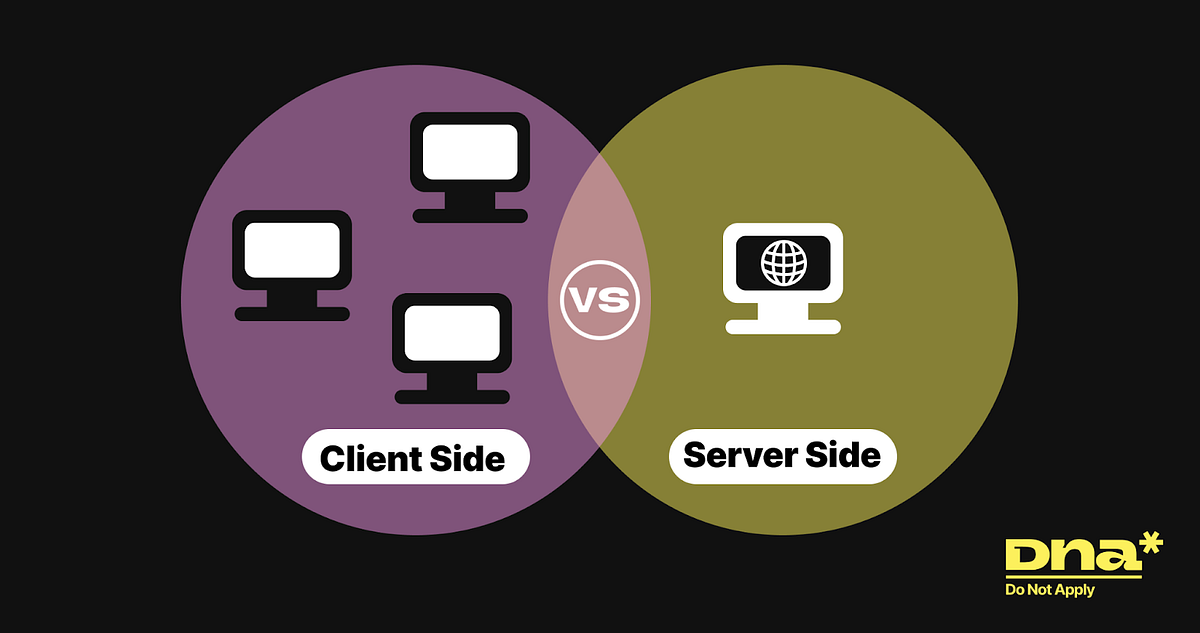In the world of web development, understanding the roles of client-side and server-side scripting is crucial. Imagine this: you're at a restaurant ready to order a delicious meal.
-
Imagine a restaurant: You (the client) order food from a menu. The kitchen (the server) prepares your food and sends it to you.
-
Client-side scripting is like writing instructions on how you want to read the menu, choose your food, and eat it. This happens on your computer (the client).
// Example: Changing text color on a button click
const button = document.getElementById("myButton");
button.addEventListener("click", () => {
button.style.color = "red";
});
-
Server-side scripting is like the chef in the kitchen taking your order, cooking the food, and plating it. This happens on a web server, hidden from you.
<?php
// Example: Fetching data from a database
$conn = mysqli_connect("hostname", "username", "password", "database");
$result = mysqli_query($conn, "SELECT * FROM products");
?>
-
You only see the final result: the delicious food (the webpage). You don't see the chef cooking or the kitchen's mess (the server-side code).
-
Client-side languages are mostly used for making websites interactive and visually appealing (e.g., HTML, CSS, JavaScript).
-
Server-side languages handle things like storing data, processing payments, and sending emails (e.g., PHP, Python, Java).
-
Both are essential: You need both a beautiful menu and a skilled chef to have a great dining experience (a functional and interactive website).
-
JavaScript can be both: While traditionally client-side, Node.js allows JavaScript to run on servers too, blurring the lines a bit.
-
Choosing the right tool: The choice depends on what you're building. Simple websites might only need client-side scripting, while complex web applications require both.
This code demonstrates a client-server interaction using a restaurant menu. The client-side HTML displays the menu structure, while JavaScript fetches menu data from a server-side PHP script. The PHP script simulates menu data and sends it back as a JSON response. The JavaScript then dynamically updates the HTML to display the received menu items. This illustrates how client-side scripting handles presentation and user interaction, while server-side scripting manages data and logic.
This example demonstrates a simple interaction between client-side and server-side scripting using a restaurant menu analogy.
1. Client-Side (HTML, JavaScript):
<!DOCTYPE html>
<html>
<head>
<title>Restaurant Menu</title>
</head>
<body>
<h1>Our Menu</h1>
<h2>Appetizers</h2>
<ul id="appetizers">
</ul>
<h2>Main Courses</h2>
<ul id="main-courses">
</ul>
<script>
// Fetch menu data from the server
fetch('/get_menu.php')
.then(response => response.json())
.then(menu => {
// Populate appetizers
const appetizersList = document.getElementById('appetizers');
menu.appetizers.forEach(item => {
const listItem = document.createElement('li');
listItem.textContent = item;
appetizersList.appendChild(listItem);
});
// Populate main courses
const mainCoursesList = document.getElementById('main-courses');
menu.mainCourses.forEach(item => {
const listItem = document.createElement('li');
listItem.textContent = item;
mainCoursesList.appendChild(listItem);
});
});
</script>
</body>
</html>2. Server-Side (PHP):
<?php
// Simulate menu data (in reality, this could come from a database)
$menu = [
'appetizers' => ['Spring Rolls', 'Calamari', 'Soup of the Day'],
'mainCourses' => ['Steak', 'Salmon', 'Pasta Primavera']
];
// Send menu data as JSON response
header('Content-Type: application/json');
echo json_encode($menu);
?>Explanation:
-
Client-Side:
- The HTML sets up the basic structure of the menu.
- JavaScript uses
fetch to send a request to the server for menu data.
- Upon receiving the data, JavaScript dynamically updates the HTML to display the menu items.
-
Server-Side:
- The PHP script defines an array representing the restaurant menu.
- It encodes the menu data into JSON format.
- The JSON data is sent back to the client as a response to the fetch request.
How it works:
- The client (web browser) loads the HTML file.
- The JavaScript code sends a request to the server (
get_menu.php) to fetch the menu data.
- The server-side script processes the request, retrieves the menu data, and sends it back to the client as a JSON response.
- The client-side JavaScript receives the JSON data, parses it, and dynamically updates the HTML to display the menu items on the page.
This example demonstrates a simple interaction between client-side and server-side scripting, showcasing how they work together to deliver a dynamic and interactive web experience. The client-side handles the presentation and user interaction, while the server-side manages data and logic behind the scenes.
-
Think of it like a magic trick: The server-side is where the magic happens behind the curtain, while the client-side is the magician presenting the illusion to the audience.
-
Security: Server-side code is hidden from the user, making it more secure for handling sensitive tasks like processing payments or storing user data. Client-side code can be viewed and manipulated by the user, so it's important to never rely on it for security.
-
Performance: Client-side scripting can make websites faster by handling tasks directly in the user's browser, reducing the need for communication with the server. However, complex computations are best handled server-side to avoid slowing down the user's browser.
-
Examples of client-side interactions: Image carousels, form validation, animations, interactive maps, and playing audio/video.
-
Examples of server-side tasks: User authentication, database operations, sending emails, processing orders, and generating dynamic content.
-
Frameworks and libraries: Both client-side and server-side development have frameworks and libraries that make development faster and more efficient (e.g., React, Angular, Vue.js for client-side; Express.js, Django, Ruby on Rails for server-side).
-
Full-stack development: Developers who can work with both client-side and server-side technologies are called full-stack developers. They have a holistic understanding of web development and can build complete web applications.
-
The line is blurring: With technologies like WebSockets and server-side rendering, the distinction between client-side and server-side is becoming less clear-cut. However, understanding the fundamental differences remains crucial for building efficient and secure web applications.
This article explains the difference between client-side and server-side scripting using a restaurant analogy:
Client-Side Scripting (You, the Diner):
-
What it is: Like reading the menu, choosing your food, and eating it.
-
Where it happens: On your computer (the client).
-
Languages: HTML, CSS, JavaScript.
-
Purpose: Making websites interactive and visually appealing.
-
Example: Changing a button's color when clicked using JavaScript.
Server-Side Scripting (The Kitchen):
-
What it is: Like the chef taking your order, cooking, and plating your food.
-
Where it happens: On a web server, hidden from you.
-
Languages: PHP, Python, Java.
-
Purpose: Handling data storage, payments, emails, and other behind-the-scenes tasks.
-
Example: Fetching product information from a database using PHP.
Key Takeaways:
- You only see the final result (the webpage), not the server-side code.
- Both client-side and server-side scripting are essential for a functional and interactive website.
- Simple websites might only need client-side scripting, while complex ones require both.
- JavaScript can be used for both client-side and server-side scripting (with Node.js).
In conclusion, mastering the interplay between client-side and server-side scripting is akin to orchestrating a flawless dining experience. The client-side, like an elegant dining room, focuses on presentation and user interaction, while the server-side, much like a well-run kitchen, handles the behind-the-scenes magic of data management and processing. While the lines between these two realms are becoming increasingly blurred with advancements in technology, a firm grasp of their fundamental differences remains paramount for any aspiring web developer. By understanding these concepts, one can build dynamic, efficient, and secure web applications that cater to the needs of users in our increasingly interconnected world.
-
 php - Client side vs server side basics - Stack Overflow | Sep 13, 2011 ... But server side programming is that which performs all the task in the server only. So the user is unaware of that. For example, PHP is used for ...
php - Client side vs server side basics - Stack Overflow | Sep 13, 2011 ... But server side programming is that which performs all the task in the server only. So the user is unaware of that. For example, PHP is used for ...
-
 What are the differences between server-side and client-side ... | Oct 24, 2012 ... Server-side programming is writing code that runs on the server, using languages supported by the server (such as Java, PHP, C#; it is possible to write code ...
What are the differences between server-side and client-side ... | Oct 24, 2012 ... Server-side programming is writing code that runs on the server, using languages supported by the server (such as Java, PHP, C#; it is possible to write code ...
-
 php is a scripting language or server side language? - Stack Overflow | Jul 6, 2015 ... All four are programming languages. The distinction between scripting languages and compiled languages resides in the methods used to run them, ...
php is a scripting language or server side language? - Stack Overflow | Jul 6, 2015 ... All four are programming languages. The distinction between scripting languages and compiled languages resides in the methods used to run them, ...
-
 Client side programming vs Server side programming : r/webdev | Posted by u/kmaneshni - 11 votes and 17 comments
Client side programming vs Server side programming : r/webdev | Posted by u/kmaneshni - 11 votes and 17 comments
-
 Client side vs Server side: Everything you need to know | Understanding client-side and server-side scripting is essential to build your website for customers’ needs. Learn everything you need to know about client side vs. server side.
Client side vs Server side: Everything you need to know | Understanding client-side and server-side scripting is essential to build your website for customers’ needs. Learn everything you need to know about client side vs. server side.
-
 If server-side JavaScript is the newest trend, why don't we just use ... | Posted by u/jazzypants - 343 votes and 305 comments
If server-side JavaScript is the newest trend, why don't we just use ... | Posted by u/jazzypants - 343 votes and 305 comments
-
 Client-Side vs. Server-Side: What's the Difference? | Indeed.com | Learn about client-side versus server-side development, including their definitions, the programming languages developers use for each and their differences.
Client-Side vs. Server-Side: What's the Difference? | Indeed.com | Learn about client-side versus server-side development, including their definitions, the programming languages developers use for each and their differences.
-
 Client-side vs. Server-side: what's the difference? | by DoNotApply ... | We know you’re busy coding something cool. You’re short on time to study up on the difference between client-side development and…
Client-side vs. Server-side: what's the difference? | by DoNotApply ... | We know you’re busy coding something cool. You’re short on time to study up on the difference between client-side development and…
-
 The difference between Client Side And Server Side Programming | You need to know the difference between client side and server side Programming If you are new to backend processes in web development. You may have noticed that PHP rarely works in JavaScript.
The difference between Client Side And Server Side Programming | You need to know the difference between client side and server side Programming If you are new to backend processes in web development. You may have noticed that PHP rarely works in JavaScript.
 Client side vs Server side: Everything you need to know | Understanding client-side and server-side scripting is essential to build your website for customers’ needs. Learn everything you need to know about client side vs. server side.
Client side vs Server side: Everything you need to know | Understanding client-side and server-side scripting is essential to build your website for customers’ needs. Learn everything you need to know about client side vs. server side. Client-Side vs. Server-Side: What's the Difference? | Indeed.com | Learn about client-side versus server-side development, including their definitions, the programming languages developers use for each and their differences.
Client-Side vs. Server-Side: What's the Difference? | Indeed.com | Learn about client-side versus server-side development, including their definitions, the programming languages developers use for each and their differences. The difference between Client Side And Server Side Programming | You need to know the difference between client side and server side Programming If you are new to backend processes in web development. You may have noticed that PHP rarely works in JavaScript.
The difference between Client Side And Server Side Programming | You need to know the difference between client side and server side Programming If you are new to backend processes in web development. You may have noticed that PHP rarely works in JavaScript.